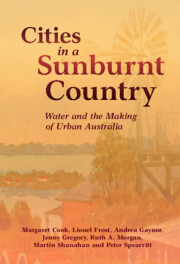Book contents
- Cities in a Sunburnt Country
- Studies in Environment and History
- Cities in a Sunburnt Country
- Copyright page
- Contents
- Figures
- Maps
- Book part
- Tables
- Acknowledgements
- 1 Prologue
- 2 Living Water
- 3 Domesticating Water
- 4 Keeping Up
- 5 Transforming Homes
- 6 Watering Suburbia
- 7 Crises of Confidence
- 8 Twenty-First Century Australian Cities
- 9 Epilogue
- References
- Index
- Studies in Environment and History
3 - Domesticating Water
Published online by Cambridge University Press: 19 May 2022
- Cities in a Sunburnt Country
- Studies in Environment and History
- Cities in a Sunburnt Country
- Copyright page
- Contents
- Figures
- Maps
- Book part
- Tables
- Acknowledgements
- 1 Prologue
- 2 Living Water
- 3 Domesticating Water
- 4 Keeping Up
- 5 Transforming Homes
- 6 Watering Suburbia
- 7 Crises of Confidence
- 8 Twenty-First Century Australian Cities
- 9 Epilogue
- References
- Index
- Studies in Environment and History
Summary
White settlers domesticated water by shaping and regulating natural water features into systems of dams, piped networks, and waste disposal facilities. Clean water is a common resource when there is no restriction on its use, and each use of the resource makes less available to others. Overuse of common water resources was an early feature of the five cities, and effective solutions were the product of democratic institutions that empowered citizens to take collective action and express demands for improved infrastructure. In Sydney, Melbourne, and Adelaide, sanitary reform through investment in networked water infrastructure in response to the threat of cholera was underway by the mid-nineteenth century; the development of effective sewerage was delayed by the costs of extension across large metropolitan areas and the fragmentation of political authority between local councils. The smaller cities, Brisbane and Perth, were slower to invest, and water supplies continued to be unreliable and subject to pollution from cesspits. By the start of the twentieth century, variations in water infrastructure systems reflected the path-dependent nature of earlier solutions, which would constrain the options available to future decision makers.
Keywords
- Type
- Chapter
- Information
- Cities in a Sunburnt CountryWater and the Making of Urban Australia, pp. 46 - 80Publisher: Cambridge University PressPrint publication year: 2022



